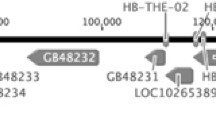Summary
Recently in our wild stock of the monogenic blowfly Chrysomya rufifacies a recessive mutation “white” (w) causing white instead of red-brown eyes spontaneously appeared (Fig. 1). This marker gene enabled us to clarify the genetic basis of monogeny in this species. F1 offspring produced by reciprocal crossings between normal (+/+) and white-eyed (w/w) flies were phenotypically wildtype (Table 1). In F2 offspring of female-producing (thelygenic) and male-producing (arrhenogenic) F1 females wildtype and white-eyed flies appeared in the expected 3:1 ratio; in several crossings a slight deviation of this ratio indicated a reduced viability of the w/w individuals (Table 2). Examination of F2 progeny of thelygenic F1+/w females, which had received the w allele from their father, showed that most of the F2+/+ females were thelygenic, whereas most of the F2 w/w females were arrhenogenic; among F2+/w females thelygenic and arrhenogenic individuals occurred in almost equal numbers (Table 3). On the other hand, when F2 offspring of thelygenic F1+/w females which had inherited the w allele from their mother were tested, most of the F2+/+ females turned out to be arrhenogenic and most of the F2 w/w females thelygenic; among F2+/w females thelygenic and arrhenogenic flies also were found in almost equal frequencies (Table 4). the sex-linked inheritance of the factor w following from these results was also confirmed by an analysis of the progeny of thelygenic F1+/w females backcrossed with w/w males. Among the R1 offspring of F1+/w females, which had received the w allele from their father, the +/w females were predominantly thelygenic compared to their predominantly arrhenogenic w/w sisters (Table 5). Analysis of R1 progeny of F1+/w females, which had inherited the w allele from their mother, yielded reciprocal results (Table 6).
This mode of incomplete sex-linkage of the mutation “white” observed in C. rufifacies (Figs. 2–5) supports the hypothesis that thelygenic females are heterozygous for a dominant female sex realizer (F') with predetermined sex-determining properties, and that arrhenogenic females as well as the males are homozygous for the recessive allele f (Fig. 6). The recombination frequency between F'/f and the w-Locus was calculated to be 12.72±0.72 per cent.
Similar content being viewed by others
Literatur
Anders, A., Anders, F.: Monogenie bei Sminthurides aquaticus Bourl. (Collembola). Zool. Anz., Suppl. 23, 81–91 (1960)
Bauer, H.: Die wachsenden Oocytenkerne einiger Insekten in ihrem Verhalten zur Nuklealfärbung. Z. Zellforsch. 18, 254–298 (1933)
Bier, K.: Synthese, interzellulärer Transport und Abbau von Ribonucleinsäure im Ovar der Stubenfliege Musca domestica. J. Cell Biol. 16, 436–440 (1963a)
Bier, K.: Autoradiographische Untersuchungen über die Leistungen des Follikelepithels und der Nährzellen bei der Dotterbildung und Eiweißsynthese im Fliegenovar. Wihelm Roux' Arch. Entwickl.-Mech. Org. 154, 552–575 (1963b)
Bier, K., Kunz, W., Ribbert, D.: Struktur und Funktion der Oocytenchromosomen und Nukleolen sowie der Extra-DNS während der Oogenese panoistischer und meroistischer Insekten. Chromosoma (Berl.) 23, 214–254 (1967)
Bridges, C. B.: A linkage variation in Drosophila. J. exp. Zool. 19, 1–21 (1915)
Bridges, C. B.: The realtion of the age of the female to crossing over in the third chromosome of Drosophila melanogaster. J. gen. Physiol. 8, 698–700 (1927)
Bulnheim, H.-P.: Mikrosporidieninfektion und Geschlechtsbestimmung bei Gammarus duebeni. Zool. Anz. Suppl. 30, 432–442 (1967)
Bulnheim, H.-P.: Zur Analyse geschlechtsbestimmender Faktoren bei Gammarus duebeni (Crustacea, Amphipoda). Zool. Anz., Suppl. 32, 244–260 (1969)
Bulnheim, H.-P., Vávra, J.: Infection by the microsporidian Octosporea effeminans sp. n., and its sex determining influence in the amphipod Gammarus duebeni. J. Parasit. 54, 241–248 (1968)
Crouse, H. V.: The nature of the influence of X-translocations on sex of progeny in Sciara coprophila. Chromosoma (Berl.) 11, 146–166 (1960a)
Crouse, H. V.: The controlling element in sex chromosome behavior in Sciara. Genetics 45, 1429–1443 (1960b)
Crouse, H. V.: Experimental alterations in the chromosome constitution of Sciara. Chromosoma (Berl.) 16, 391–410 (1965)
Dalens, H.: Contribution a l'etude des phénomènes d'intersexualite et de monogénie dans le genre Chaetophiloscia (Isopoda, Oniscoidea). II. La monogénie chez Chaetophiloscia elogata (Dollfus) et Ch. sicula (Verhoeff). Bull. biol. France Belg. 105, 3–52 (1971)
King, R. C., Burnett, R. G.: Autoradiographic study of uptake of tritiated glycine, thymidine and uridine by fruit fly ovaries. Science 129, 1674–1675 (1959)
Lattin, G. de: Über die Bestimmung und Vererbung des Geschlechts einiger Oniscoideen (Crust. Isop.). II. Mitteilung: Zur Vererbung der Monogenie von Cylisticus convexus (Deg.). Z. indukt. Abstamm.-u. Vererb.-Lehre 84, 536–567 (1952)
Metz, C. W.: Chromosome behavior, inheritance, and sex determination in Sciara. Amer. Naturalist 72, 485–520 (1938)
Roy, D. N., Siddons, L. B.: On the life history and bionomics of Chrysomyia rufifacies Macq. (Order Diptera, Family Calliphoridae). Parasitology 31, 442–447 (1939)
Sirlin, I. L., Jacob, I.: Cell function in the ovary of Drosophila. Exp. Cell. Res. 20, 283–293 (1960)
Ullerich, F.-H.: Monogene Fortpflanzung bei der Fliege Chrysomyia albiceps. Z. Naturforsch. 13b, 473–474 (1958)
Ullerich, F.-H.: Geschlechtschromosomen und Geschlechtsbestimmung bei einigen Calliphorinen (Calliphoridae, Diptera). Chromosoma (Berl.) 14, 45–110 (1963)
ullerich, F.-H.: Sex-linkage and sex determination in a monogenic blowfly. Naturwissenschaften 58, 626 (1971)
Yanagimachi, R.: Studies on the sexual organization of the Rhizocephala. III. The mode of sex determination in Peltogasterella. Biol. Bull. 120, 272–283 (1961)
Zumpt, F.: Myasis in man and animals in the old world. London: Butterworths 1965
Author information
Authors and Affiliations
Additional information
Angenommen von f. Kaudewitz
Mit Unterstützung durch die Deutsche forschungsgemeinschaft.
Rights and permissions
About this article
Cite this article
Ullerich, FH. Die genetische Grundlage der Monogenie bei der Schmeißfliege Chrysomya rufifacies (Calliphoridae, Diptera) . Molec. Gen. Genet. 125, 157–172 (1973). https://doi.org/10.1007/BF00268869
Received:
Issue Date:
DOI: https://doi.org/10.1007/BF00268869




